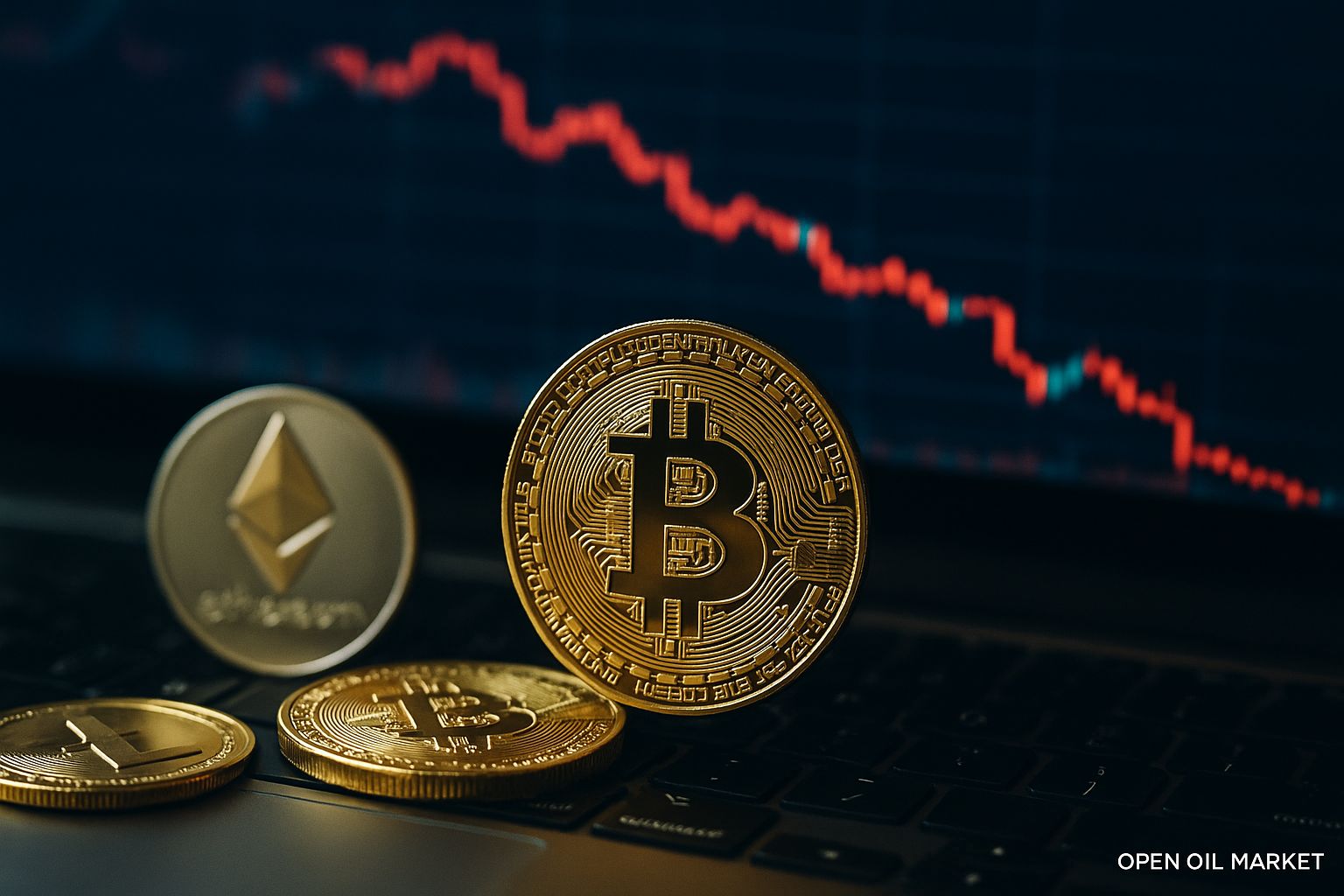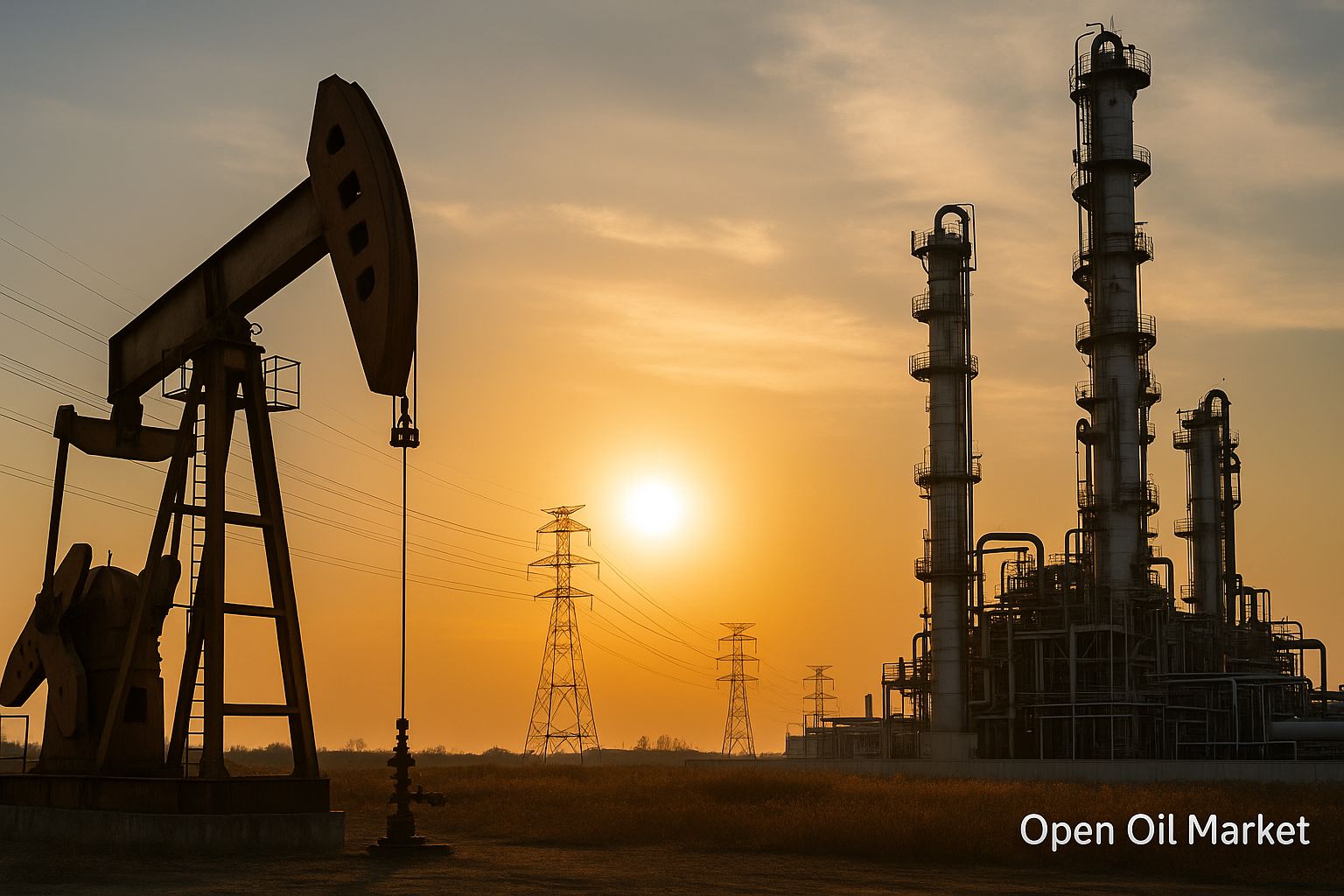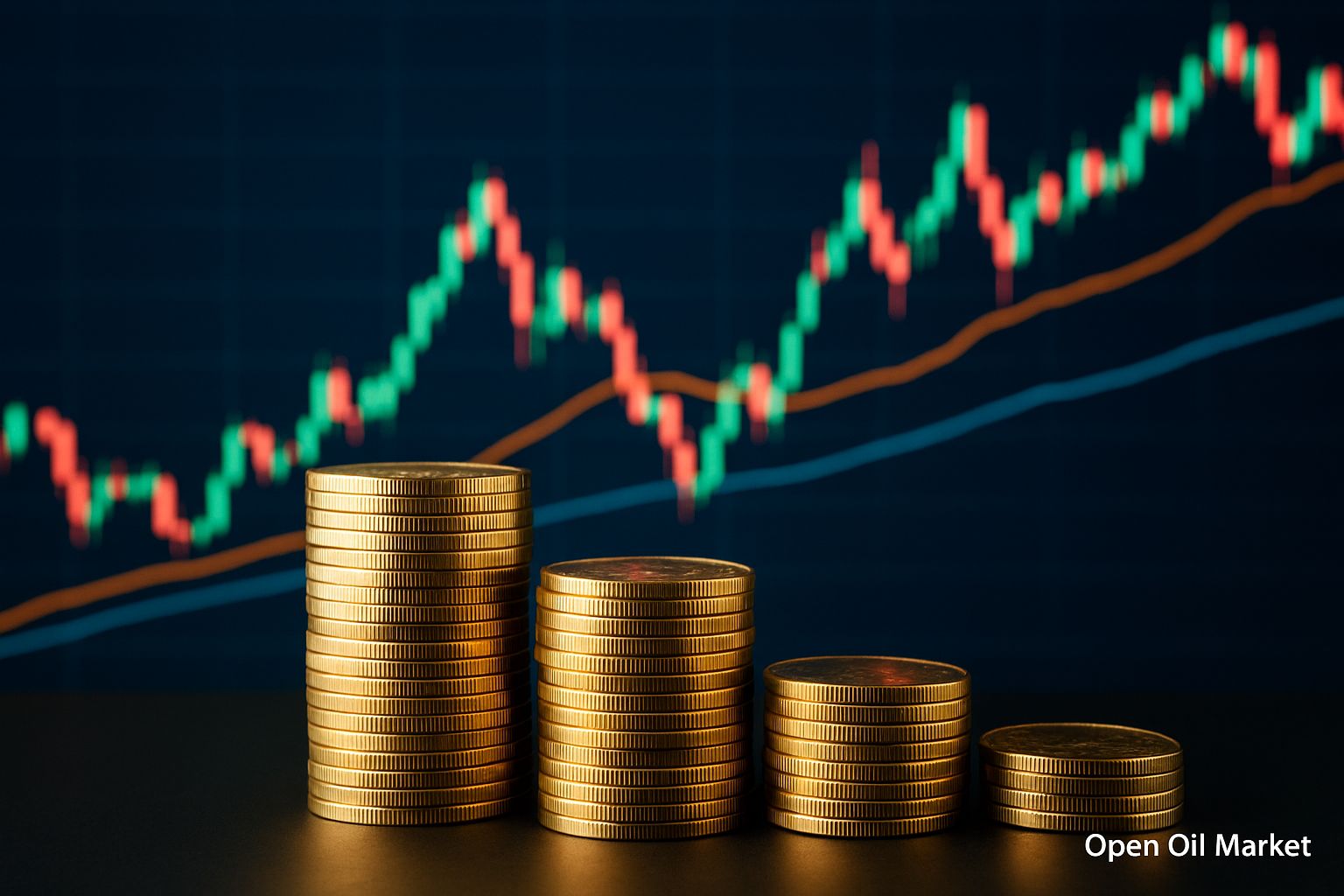
Energy Sector News – Thursday, July 31, 2025: Brent Surpasses $72; U.S. Federal Reserve Keeps Rates Unchanged
As July comes to a close, the global fuel and energy sector displays moderate growth and signs of stabilization. Oil prices continue to rise, with Brent briefly exceeding the $72 per barrel mark for the first time since late June, driven by persisting geopolitical risks and strong seasonal demand. The European gas market maintains relative stability, thanks to active filling of underground storage facilities ahead of winter. Simultaneously, regulators and market participants are taking steps to maintain balance: the OPEC+ alliance is preparing to increase oil production in August to avoid shortages, while the U.S. Federal Reserve’s decision to keep interest rates unchanged signals stability in macroeconomic conditions, boosting investor optimism. In Russia, the recently implemented ban on gasoline exports is aimed at cooling domestic fuel prices during the peak summer demand period. Below is a detailed overview of key events and trends in the oil, gas, electricity, and other segments of the energy sector as of July 31, 2025.
Oil Market: Brent Surpasses $72, Geopolitical Factors and Demand Support Growth
Oil prices continue their upward movement. The North Sea Brent blend is close to monthly highs, surpassing the psychologically significant $72 per barrel for the first time since late June. Meanwhile, American WTI is holding steady around $69. Several factors are fueling the price increase:
- Trade De-escalation Between the U.S. and Allies: A framework agreement between Washington and Brussels has prevented the escalation of trade disputes. The parties agreed on mutual tariff reductions and significantly increased exports of U.S. energy resources to Europe, improving investor sentiment and bolstering expectations for rising demand for U.S. oil and gas. The U.S. has also intensified discussions with India to remove trade barriers, mitigating global tensions.
- Geopolitical Risks and Sanctions: President Donald Trump has escalated rhetoric concerning Moscow, presenting an ultimatum to resolve the conflict in Ukraine within approximately ten days. He has threatened to impose 100% tariffs on Russian exports and secondary sanctions on countries purchasing Russian oil if progress is not made. These statements have increased uncertainty regarding global supplies and added a risk premium to oil prices.
- OPEC+ Actions: OPEC+ member countries continue to gradually increase supply. In August, total production quotas will rise by approximately 548,000 barrels per day (above the initial plan); similar increases are likely in September. Recently, the OPEC+ Joint Monitoring Committee reaffirmed commitment to the agreement and readiness to boost production to prevent shortages in the fall – these signals temper further price rallies.
As a result of the cumulative impact of these factors, the oil market remains relatively balanced. Brent has stabilized in the range of around $70–72 per barrel: recent upward momentum is being offset by expectations of increased supply from OPEC+. Despite the recent surge, current oil prices are still 10–15% below levels from a year ago, reflecting a market correction following peaks during the energy crisis of 2022–2023. Investors are also monitoring external economic signals: negotiations between the U.S. and China regarding trade disputes are ongoing, and the U.S. Federal Reserve did indeed keep rates unchanged following its meeting on July 30. Soft monetary conditions combined with the resolution of trade disagreements may support fuel demand in the latter half of the year.
Gas Market: Storage Facilities Filling Up, Prices Remain High
The gas market is primarily focused on Europe. EU countries are rapidly filling underground gas storage facilities in preparation for the winter season. By the end of July, European UGS facilities are over 72% full (compared to ~59% a month earlier), equating to over 75 billion cubic meters of reserves. Although the rate of injections slowed slightly in July compared to the record 12–13 billion m3 injected in June, the EU has managed to reduce the gap from last year's filling schedule. The target – to reach at least 90% full by the heating season – currently seems achievable. (For comparison, last year on the same date, reserves exceeded 83%, but the gap is gradually narrowing.)
Gas prices are being maintained at elevated levels. The basic European TTF index fluctuates around $400 per thousand cubic meters, roughly corresponding to the same period last year. The summer heat in Western Europe is increasing the load on power grids (massive air conditioning use), partially raising gas consumption at power plants. Simultaneously, sunny weather contributes to a high output of solar energy, which helps moderate demand for gas during peak generation hours. Stable liquefied natural gas (LNG) supplies and relatively weak industrial demand maintain balance in the market. Overall, European gas prices are currently significantly lower than the crisis peaks of 2022; however, any supply disruptions or an early cold spell in the fall could once again heighten volatility.
Global Agreements and Policy: Trade De-escalation and Sanction Pressures
In international affairs, a significant recent development has been the U.S.-EU trade and energy deal, accompanying enhanced sanctions pressures on Russia. Washington and Brussels have crafted agreements aimed at preventing a new trade war: mutual understanding on tariff reductions and increased exports of energy resources from the U.S. to Europe has been achieved. The energy component of the agreement benefits both sides: the EU gains additional guarantees for gas and oil supplies, while the U.S. expands its markets and attracts capital as exports grow. The positive trade signals have translated into increased market confidence regarding stable demand.
Concurrently, the U.S. administration continues to ramp up pressure on Moscow. President Trump has significantly shortened the deadline for achieving a ceasefire in Ukraine – the ultimatum given at the end of July allows about ten days – and has indicated that he is "not concerned" about the markets' response to potential new stringent measures against Russia. These might include immediate maximum tariffs on Russian goods and secondary sanctions against buyers of Russian energy resources. The prospect of such actions keeps market participants on edge, considering the potential risks to global oil and petroleum product supply chains.
Thus, at the global level, two opposing trends are currently interwoven: the de-escalation of trade conflicts between major economies on one hand, and the escalation of geopolitical rhetoric on the other. The outcomes of these processes will largely determine the conditions of global energy trade. Investors are closely monitoring whether the economic benefits of new export opportunities (due to trade deals) will outweigh the potential negatives of sanction restrictions and conflict – this will shape the long-term balance of demand and supply for energy resources.
Electricity and Renewable Energy: Record Consumption and Growth of Green Generation
Abnormal weather this summer is breaking new records in the energy sector and underscoring the importance of renewable energy sources (RES). In July, China recorded record load on its energy system: peak electricity demand reached an all-time high of around 1.5 TW (1.5 billion kW). This level is linked to extreme heat and widespread use of air conditioning. However, solar power plants contributed about half of the increase in electricity generation in China, and hydroelectricity also increased generation compared to the previous year – this helped partially compensate for the surge in demand and avoid major disruptions.
In the U.S., the rapid development of RES is already changing the electricity generation structure. As of March 2025, the share of wind and solar energy in U.S. electricity production reached nearly 24%, surpassing contributions from coal and nuclear power plants (each of which provided less than 20%). Combined, all renewable sources (including hydro, biomass, etc.) accounted for about 26% of electricity generation in the U.S. in the first quarter, and by mid-year this figure rose to a record 32%. Thus, "green" energy in the U.S. has surpassed coal for the first time and is gradually catching up with nuclear generation in significance.
For Europe, the increase in RES share has also become a strategic trend, especially following the recent energy crisis. In 2023, when some EU countries temporarily increased coal generation due to gas shortages, CO2 emissions skyrocketed, and electricity prices surged. However, by 2025, the situation has stabilized: gas storages are full, and new wind and solar generation capacities have been introduced, causing the share of coal in the EU's energy balance to decline once again. Despite new temperature records (for instance, extreme heat in late July led to water overheating at some nuclear power plants, complicating their cooling), Europe's energy system is withstanding peak loads without major outages. Grid operators are activating emergency readiness modes during extreme heat days, and renewable sources are increasingly taking on a larger share of meeting demand. Overall, summer 2025 demonstrates the resilience of the electricity sector: even during challenging conditions, consumers are assured of electricity, significantly due to record outputs from RES.
Coal Sector: High Demand Amid Stable Prices
Coal continues to play a notable role in the energy balance of many countries, despite the global trend toward decarbonization. According to the International Energy Agency, global coal consumption in 2025 is expected to remain near historic highs and may even break records. Global production is projected to reach approximately 9.2 billion tons this year, largely driven by increased coal usage in Asia. In countries like India and a significant portion of Southeast Asia, coal-fired generation continues to rise to meet growing electricity demand.
China, the largest consumer of coal, is likely to maintain its combustion volumes at last year’s levels or decrease them slightly in 2025 (an expected reduction of less than 1% compared to 2024). Meanwhile, European countries, having filled their gas storages and launched new RES capacities, are scaling back coal-fired generation. After a surge in coal generation during 2022–2023 (when coal temporarily replaced expensive gas), the share of coal in the EU energy system is reverting downward. Nevertheless, coal remains an important energy source in some Eastern European economies – for example, in Poland, the Czech Republic, and Greece – where its share in generation is still significant.
In recent months, coal prices on the global market have shown moderate dynamics. Futures for energy coal (API2 index) are trading in the range of $110–120 per ton (Rotterdam port, end of July). This is slightly above early summer levels (prices have risen by ~5–7% over the past month), yet still significantly below prices from a year ago (coal was 15–20% more expensive in the summer of 2024). This pricing pattern reflects a balance: on one hand, global coal demand remains high (especially during heat waves when coal is heavily used to meet peak loads); on the other hand, market supply is adequate, and consumers have built significant reserves. Major exporters – such as Australia, Indonesia, Russia, and South Africa – are maintaining steady supplies in the global market. In developed countries, the trend towards reducing hydrocarbon generation continues: environmental regulations and tax policies make new coal projects less attractive. However, in Asia, as noted, some nations are temporarily increasing coal burn to avoid purchasing expensive gas. As a result, global coal consumption remains at a plateau. In 2026, IEA analysts expect the beginning of a gradual decline in global coal demand – contingent on accelerating the energy transition and shifting China's economy towards gas and RES. For now, however, the coal sector is delivering nearly record levels of electricity production worldwide, remaining an essential component of energy supplies.
Oil Products and Refining: Regional Contrasts
The market for oil products is developing differently across various parts of the world. In Russia, authorities recently took an unprecedented step to stabilize domestic fuel prices. As of July 30, a temporary full ban on gasoline exports for all companies, including major producers and refineries, has come into effect, lasting until August 31, 2025. This emergency measure is aimed at preventing fuel shortages in the domestic market and curbing the wave of price increases during the peak summer demand period (vacation season and harvest campaign). Previously, restrictions applied only to traders and small refiners; however, wholesale gasoline prices reached new highs by the end of July, prompting the government to use administrative measures. Consequently, Russian refineries are directing nearly all gasoline volumes to the domestic market. An increase in supply on the exchange is expected to cool prices, which had reached record levels in June and July. Following the announcement of the export ban, the exchange price of AI-92 gasoline dropped by more than 1.5%, reflecting a decline in hype.
Summer brings an acceleration in gasoline prices, and regulators need to take action. The export ban should cool prices on the exchange and in retail. Likely, in the short term, this measure will have the necessary effect; otherwise, regulators will extend the ban for a longer period.
— Sergey Tereshkin, Forbes
Thus, the example of Russia illustrates that even one of the largest gasoline exporters is willing to limit external sales for the sake of domestic consumers – underscoring the presence of local fuel imbalances across different regions of the world. A contrasting scenario is observed in the U.S., where the domestic fuel market is currently experiencing a phase of relative abundance. Thanks to high refining volumes at American refineries and atypically soft summer demand, gasoline prices in the U.S. have dropped to multi-year lows. The national average gasoline price fell to around ~$3.14 per gallon (approximately $0.83 per liter) after Independence Day – a record low for the summer season in the past four years. Analysts suggest that in August–September, the average price nationwide may break the psychological $3/gallon mark, a level not seen since spring 2021.
The reasons for the decline in fuel prices in the U.S. are complex. Firstly, summer demand has proven to be slightly weaker than expected: according to the Department of Energy, gasoline consumption in early July was 1–2% lower than a year ago. Abnormal heat in the southern states has partially reduced long-distance travel; furthermore, the rising popularity of remote work and cost-saving measures are lowering drivers’ mileage. Secondly, gasoline supply has increased: American refineries are operating at high capacity, and fuel imports from Europe and Canada have surged onto the East Coast. In June, the U.S. imported approximately 100,000 barrels of gasoline per day – a maximum for more than a year. Wholesale bases and storage facilities are full, leading to price declines in bulk and passing this onto retail. Thirdly, relatively low oil prices in the first half of the year (WTI rates are now ~20% lower than last year) have reduced costs for refiners, allowing them to partially transfer this benefit onto end consumers.
The decrease in American fuel prices coincides with improvements in the refining situation. Spring maintenance at refineries has concluded, and production of gasoline and diesel is at a seasonally high level. An additional factor is OPEC+ actions: the cartel's increase in oil production in August will enhance raw material availability and exert downward pressure on global oil prices, thereby indirectly facilitating further gasoline price reductions. In other words, the current U.S. oil products market is favorable for consumers: supply exceeds demand, prices are gradually falling without shortages.
In Europe, the situation with motor fuel prices is relatively stable. After the turmoil of 2022–2023, during which sanctions and logistical restructuring led to sharp price fluctuations, the gasoline and diesel markets in 2025 have achieved equilibrium. Wholesale gasoline prices are currently close to early-year levels and significantly below last year's peaks. Contributing factors include relatively cheap oil (around $70 compared to >$100 a year ago) and successful reorientation of oil product imports: the EU has established steady diesel supply channels from the Middle East, Asia, and the U.S. to replace Russian volumes. As the expensive batches of fuel purchased by European importers last winter are consumed and replaced by cheaper supplies, gas stations in the EU are gradually lowering retail prices. However, due to high taxes and levies, gasoline in Europe remains expensive for consumers – prices in the largest EU economies range from €1.6–1.8 per liter at gas stations.
Overall, the global oil products market is not currently experiencing acute shortages, although regional differences persist. In some developing countries (such as Pakistan, Bangladesh, and several African states), high prices for imported fuel create tension – authorities are forced to subsidize gasoline for the public to avoid social discontent. Meanwhile, in the Middle East and India, oil refining is hitting record highs: local refineries, focused on exporting diesel and jet fuel, are operating at maximum capacity, saturating the global market with products. On the other hand, structural changes in the sector – such as the closure of several outdated refineries in Western Europe and the U.S. (including conserving some capacities in California) – create risks of local supply reduction in the future. For now, however, summer 2025 proceeds relatively calmly for the oil products market: fuel prices are either decreasing or stabilizing, and consumers worldwide are generally supplied with gasoline and diesel without disruption.
Outlook: Key Factors to Watch
A number of factors remain on the horizon that could influence the dynamics of the global energy sector in the near future:
- Monetary Policy: Future decisions by central banks (especially the U.S. Federal Reserve) regarding interest rates and the dynamics of the dollar’s exchange rate may impact borrowing costs, investments, and consequently, demand for energy resources.
- Sanctions and Trade Disputes: The evolution of sanction rhetoric towards Russia (including potential new restrictions from the U.S.) and the course of trade negotiations between the U.S. and China, India, and other countries will affect global oil and gas supply chains.
- Economic Growth and Demand: Macro-economic indicators in key countries – growth rates of GDP and industry in China, the U.S., Europe, and India – will determine the consumption dynamics for oil, gas, and electricity. Strong data (such as a 3% GDP growth in the U.S. in Q2 2025) supports optimism; however, economic slowdowns anywhere could cool fuel demand.
- Filling of Gas Storage Facilities: Europe’s progress towards achieving the 90% filling target for UGS by the heating season and ensuring alternative gas supplies will shape the price situation in the gas market in the fall and winter.
- OPEC+ Actions: Compliance by OPEC+ countries with planned oil production increases and decisions made at upcoming alliance meetings will influence market balance and oil price dynamics.
- Fuel Market in Russia: The effect of the implemented ban on gasoline exports in Russia and subsequent decisions by authorities (cancellation or extension of the restriction after August) will impact domestic fuel prices and the potential for export shipments from Russia.





